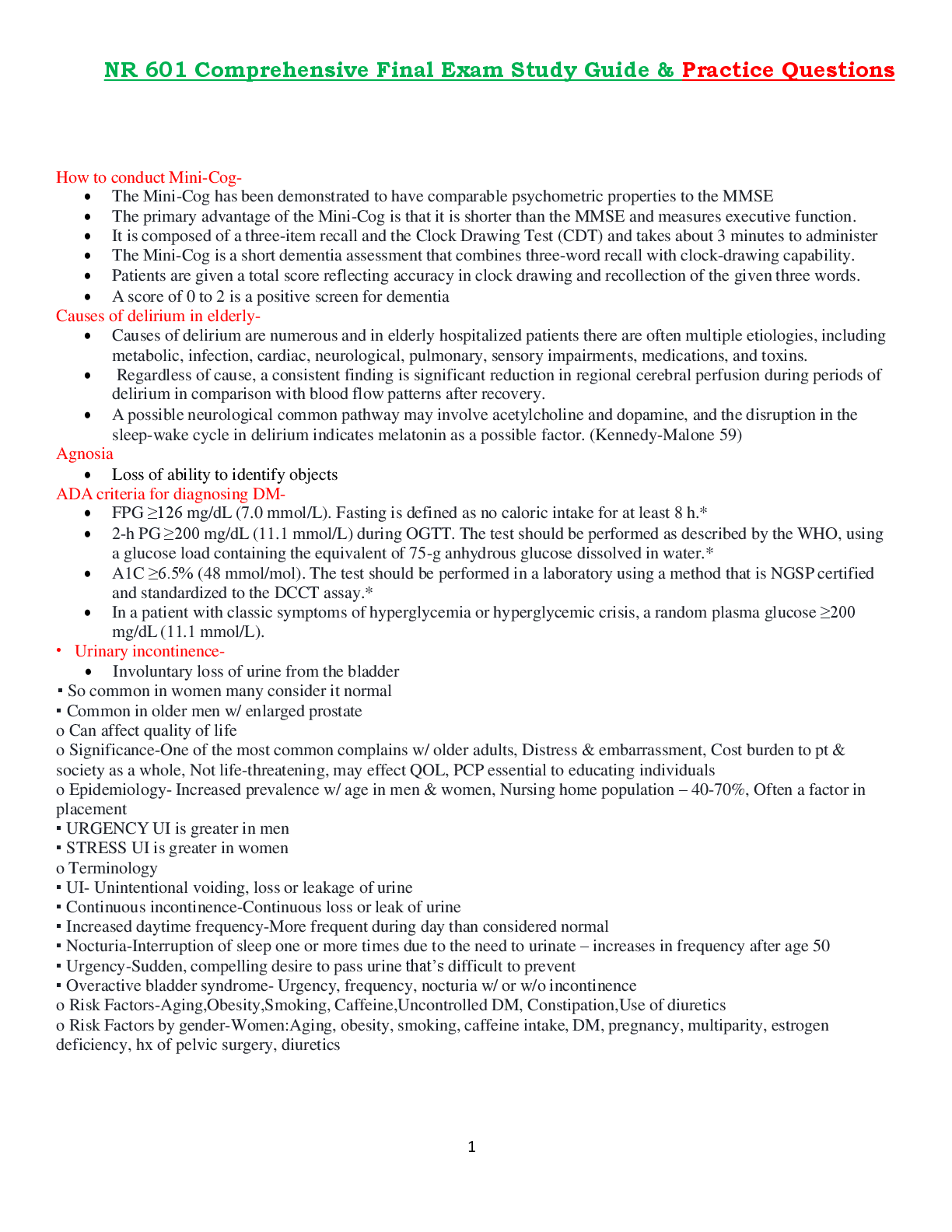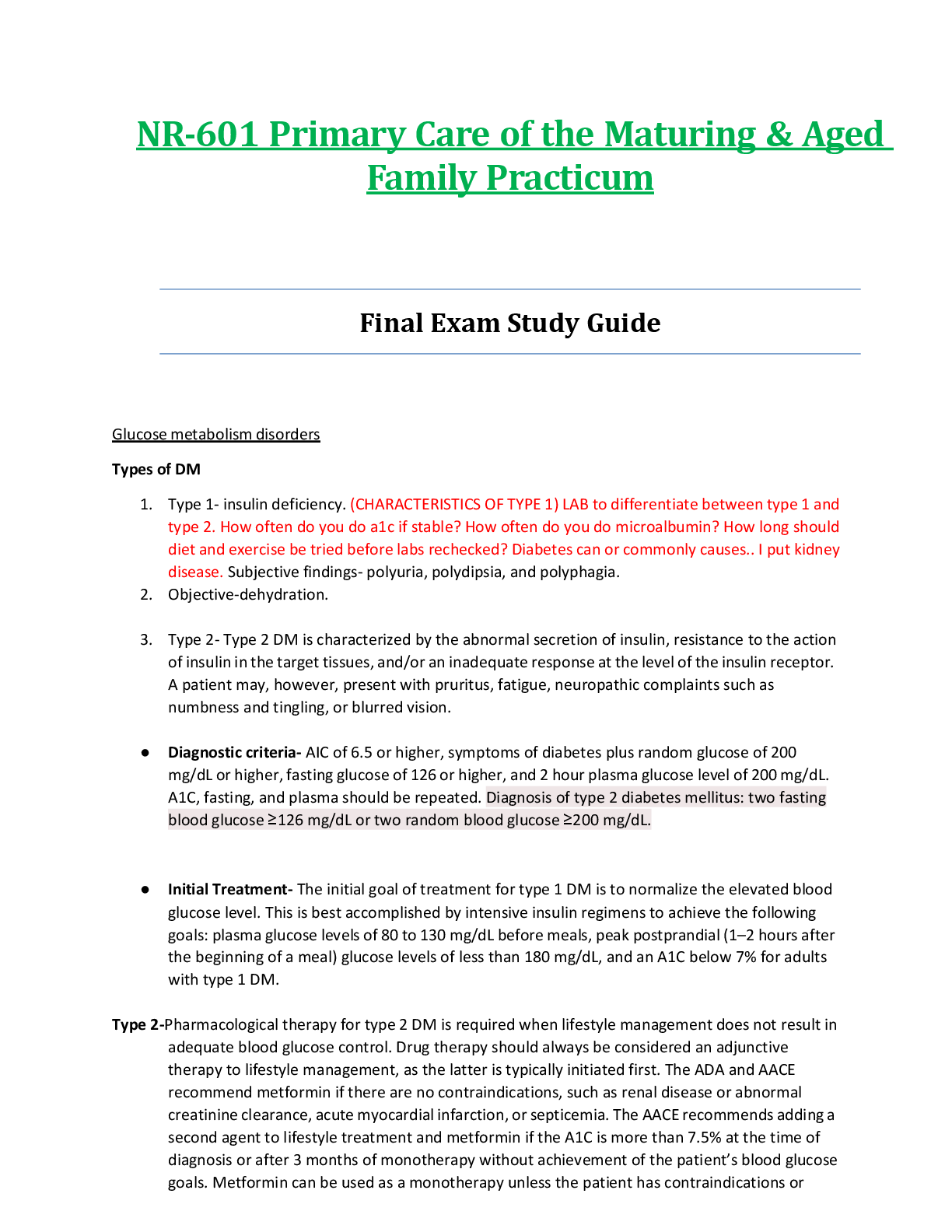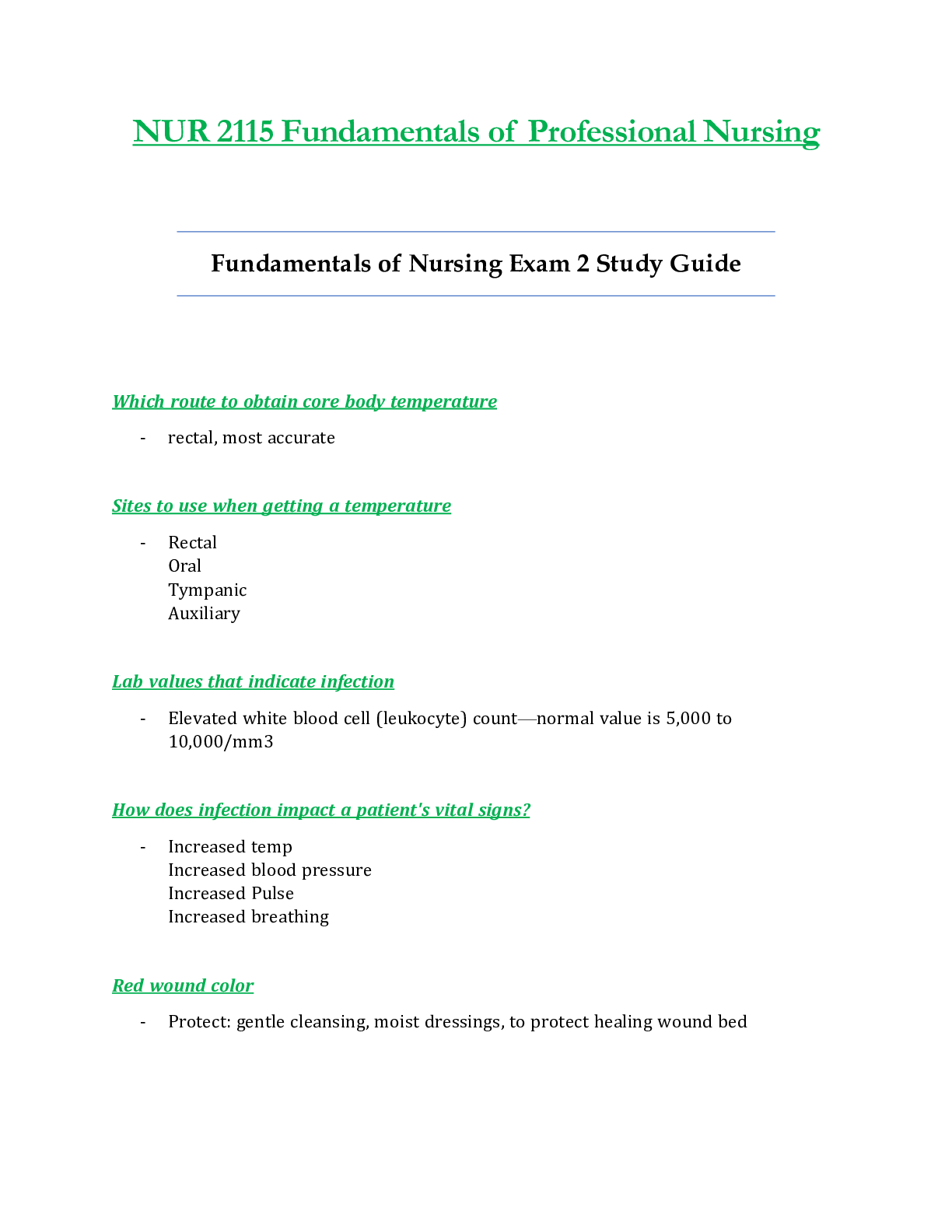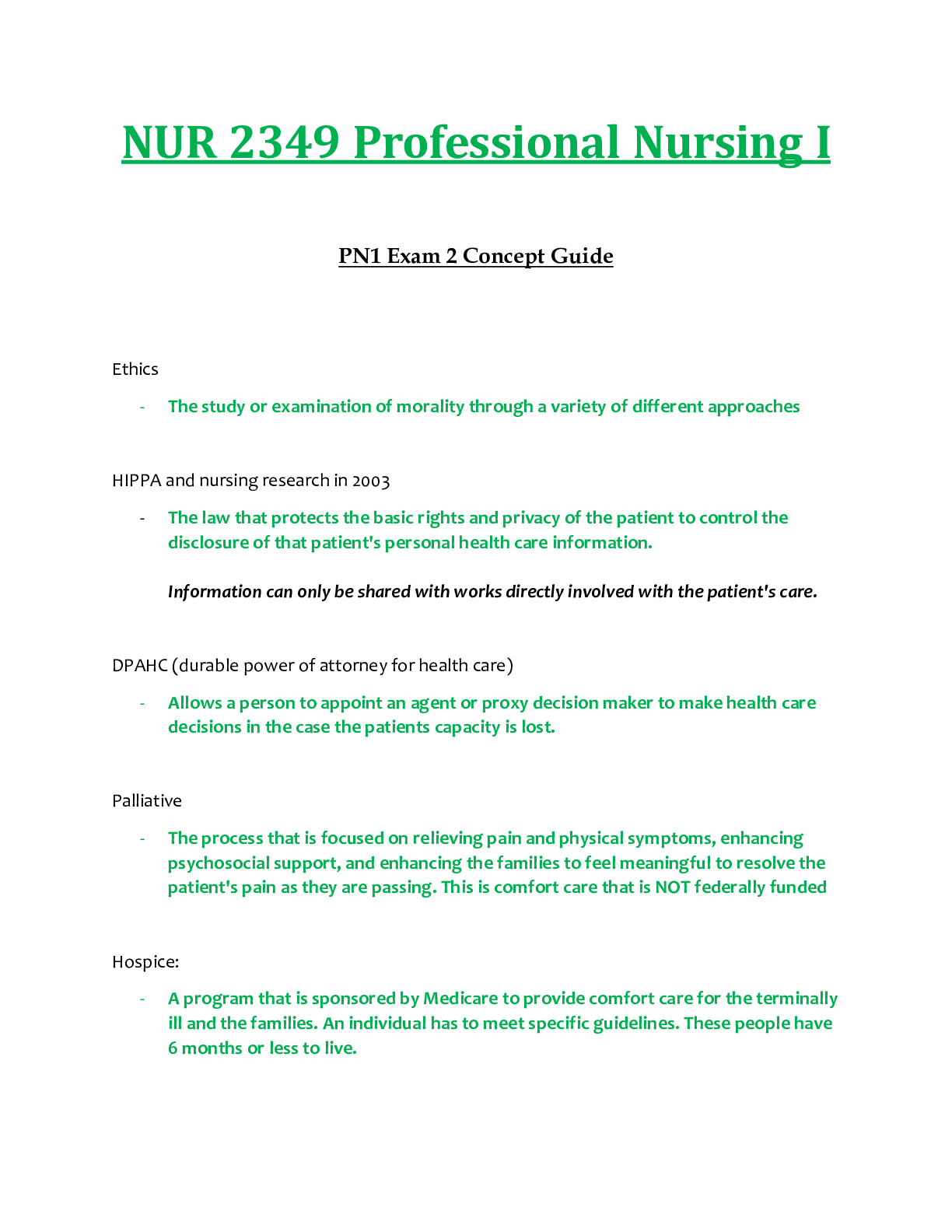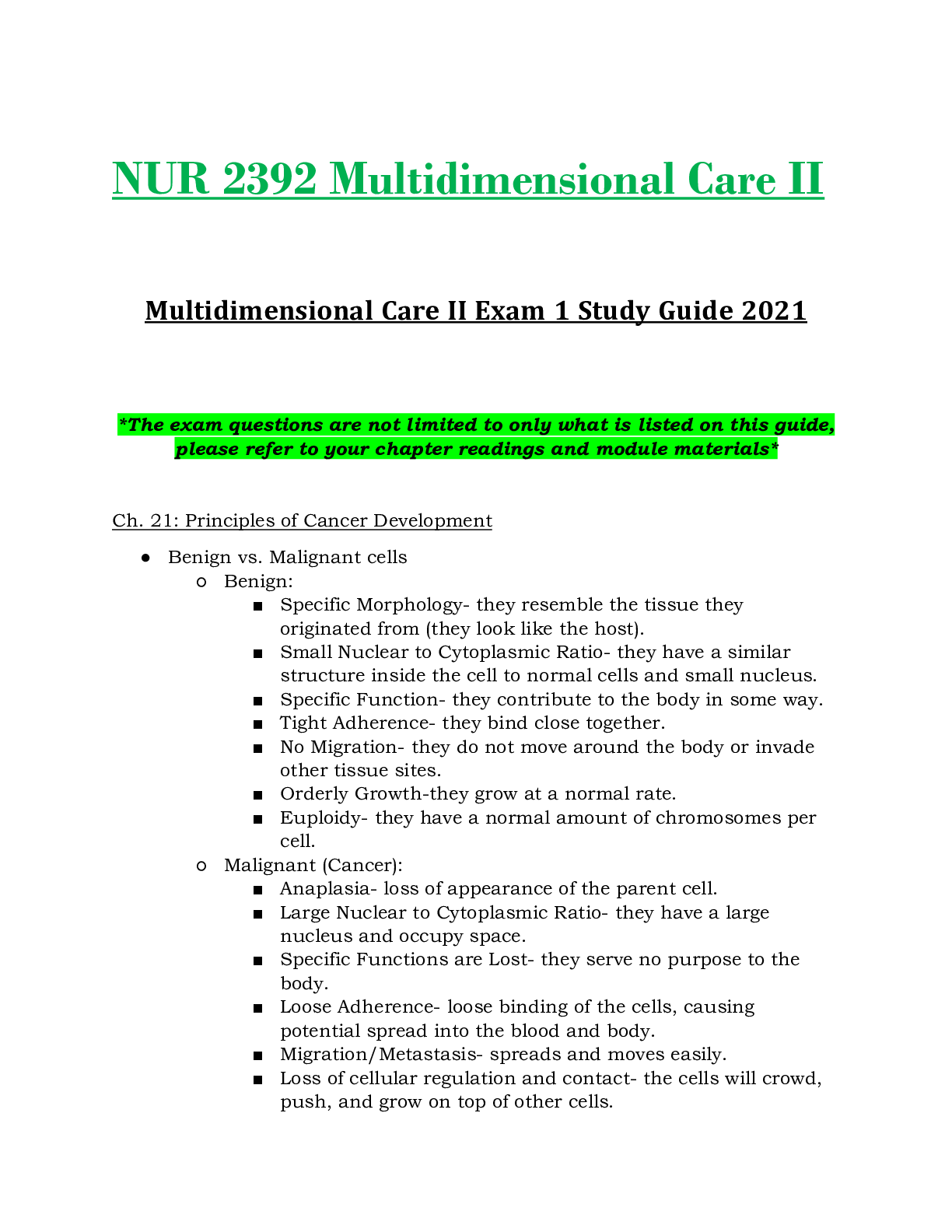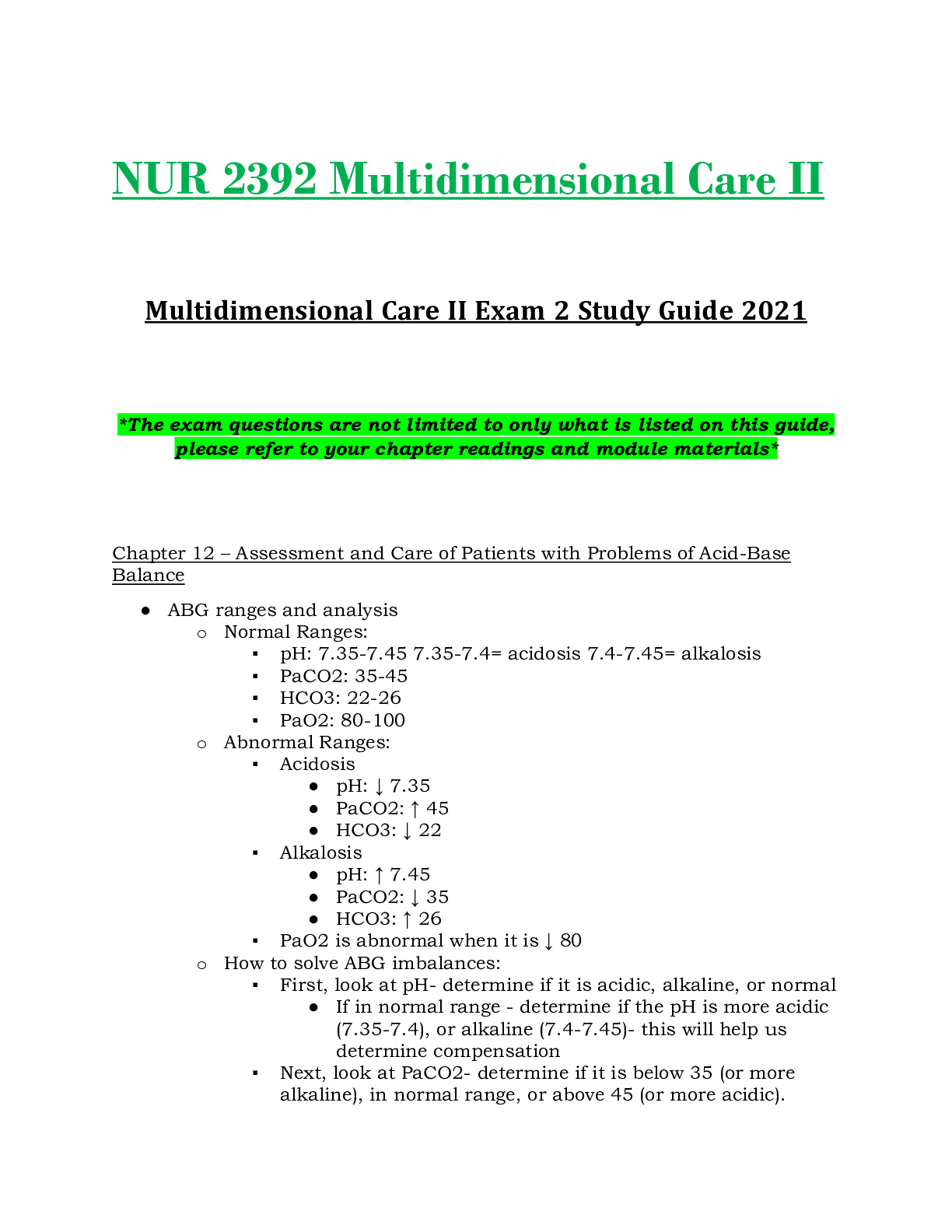*NURSING > STUDY GUIDE > NR565 / NR 565: Advanced Pharmacology Fundamentals WEEK 4 Completed Study Guide (All)
NR565 / NR 565: Advanced Pharmacology Fundamentals WEEK 4 Completed Study Guide
Document Content and Description Below
NR 565 Week 4 Chapter 35: Chronic Migraine and Cluster Headache Chronic daily headache headaches 15 or more days a month for longer than 3 months • Chronic daily headaches (CDH) can be divided into ... five subtypes: o chronic tension-type headache o chronic migraine o hemicrania continua (Not in the study guide = not covered in depth) rare disorder that responds completely to indomethacin and to nothing else. Indomethacin (Indocin) 75 to 150 mg is given daily; doses up to 200 mg daily may be needed. Referral to a neurologist is recommended. o medication-overuse headache o new daily persistent headache. • Use of drugs for acute headache treatment more than 9 days a month is associated with increased risk of chronic daily headaches. • Medication-overuse is addressed later Pathophysiology: Patho of CDH is often unclear and of mixed origin. • There is a clear difference between chronic migraine and hemicrania continua (Not in the study guide = not covered). • The boundary between chronic tension-type headache and chronic migraine is less clear and may require a neurology referral for treatment. The term chronic migraine refers to CDH that starts as episodic migraine (less than 15 days a month) that transforms into a chronic pattern of greater than 15 days a month of migraine headache • It was formerly called “transformed migraine.” • The initial migraines have the pathogenesis of migraine discussed earlier. Chronic migraine is not well understood but is thought to be related to a combination of atypical pain processing, cortical hyperexcitability, neurologic inflammation, and central sensitization. • Risk factors for chronic migraine include female gender, history of head or neck injury, life stress, psychiatric disorders, and comorbid pain disorders Goals of Treatment The first goal of treatment for CDH is to break the pattern of daily headache. The patient is then stabilized on prophylactic or preventive therapy. Rational Drug Selection Chronic Migraine In most patients with chronic migraine, the daily headache cycle can be broken by using repeated doses of IV DHE (dihydroergotamine mesylate). • Approximately 70% to 80% of patients respond to DHE. o The patient is given a test dose of 0.33 mL of DHE (1 mg/mL solution) with 5 mg of metoclopramide or 10 mg of prochlorperazine (Compazine). o Followed by 0.5 mL of DHE and one of the anti-nausea medications every 6 hours for 48 to 72 hours. o This usually requires inpatient treatment. o DHE is contraindicated in coronary and peripheral vascular disease. Alternatives to DHE: • Chlorpromazine (Thorazine) • Prochlorperazine. If the patient has medication-overuse headache due to misuse of analgesics, ergots, or combination medications, the patient has to be detoxified (Discussed later) Treatment of chronic migraine may require consultation with a neurologist. Preventive pharmacotherapy can be started after the headache cycle is broken. • The patient usually responds to migraine-preventive medications such as propranolol, divalproex, or a tricyclic antidepressant. • Amitriptyline is a good choice if the patient is also depressed. • The seizure medications topiramate or valproic acid may be used. • The patient is on preventive medication until the headache days are reduced by 50%, and then an additional 3 to 4 weeks, for a total of 6 to 12 weeks. The patient should also receive alternative therapy to treat CDH. Behavioral counseling, biofeedback therapy, relaxation therapy, physical exercise, and acupuncture are all valid alternative therapies for treatment of CDH. Monitoring Monitoring of patients with CDH who are on preventive therapy requires the patient to keep a diary of headache and medication use. • Patients’ blood pressure should be monitored if they are on a beta blocker • Liver function monitored if on divalproex, as per migraine therapy monitoring. • Ongoing monitoring of headache is necessary because 31% may have recurrence of headache in spite of preventive medication. Outcome Evaluation Patients with CDH are difficult to treat. Treatment success is determined by how effective it has been in breaking the cycle of daily headaches and how effective the preventive treatment is. The patient's headache diary is key in the evaluation of the success of treatment. Patient Education Should include a discussion of information related to the overall treatment plan as well as that specific to the drug therapy, reasons for taking the drug, drugs as part of the total treatment plan, and adherence issues. Patient education information specific to treating CDH should focus on the following principles: 1. Education about the nature of the disorder, particularly that it is biological in origin, with neurochemical changes producing the headache. 2. Overuse of analgesics, leading to medication-overuse headache, must be emphasized. 3. The influence of stress, anxiety, depression, and inability to relax should be discussed, and the patient encouraged to use nonpharmacological therapies to decrease headache. CLUSTER HEADACHES: characterized by intense pain lasting for 15 minutes to 2 hours. • Occur in “clusters” of several weeks or months, with the headache subsiding for months at a time, often to recur. • The patient can experience one to three attacks a day, usually at the same time of day. They occur most frequently at night, awakening the patient from sleep. • Men are affected more than women, with onset in their late twenties. • The pain of a cluster headache is unique in that it occurs behind or around one eye, with tearing, conjunctival injection, and drooping of the eyelid common symptoms. • There may be nasal congestion, facial flushing, and sweating. The pain is so severe that the patient is unable to lie down or sit still, often pacing the floor in pain. Pathophysiology • No clear etiology for cluster headaches. • They are most likely a neuronal disorder originating in the hypothalamus. • The clockwork-like timing of cluster headaches suggests that the circadian pacemaker or biological “clock” is dysfunctional. Goals of Treatment Relieving the pain of an acute cluster headache and decreasing the length of time of the cluster are the goals of cluster headache management. [Show More]
Last updated: 2 years ago
Preview 1 out of 42 pages

Buy this document to get the full access instantly
Instant Download Access after purchase
Buy NowInstant download
We Accept:

Reviews( 0 )
$6.00
Can't find what you want? Try our AI powered Search
Document information
Connected school, study & course
About the document
Uploaded On
Dec 02, 2020
Number of pages
42
Written in
Additional information
This document has been written for:
Uploaded
Dec 02, 2020
Downloads
0
Views
91

